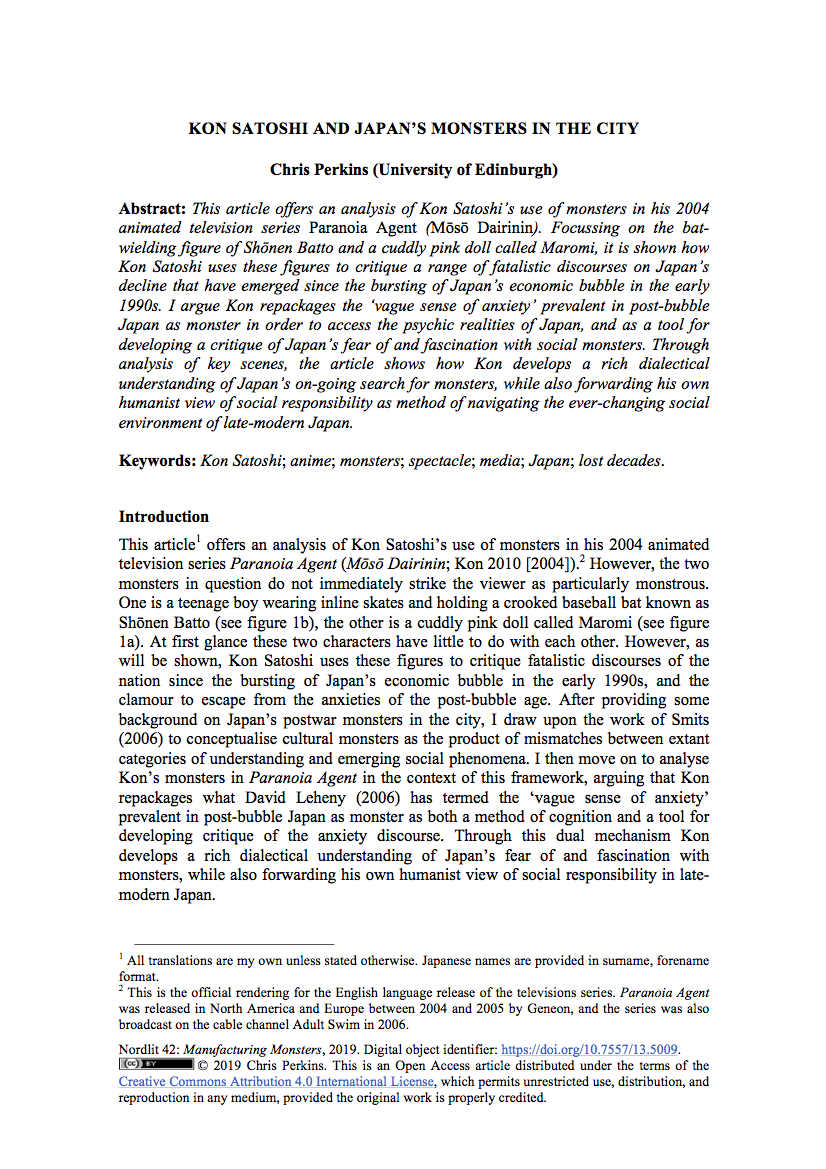Kon Satoshi and Japan’s Monsters in the City
DOI:
https://doi.org/10.7557/13.5009Keywords:
Kon Satoshi, anime, monsters, spectacle, media, Japan, lost decadesAbstract
This article offers an analysis of Kon Satoshi’s use of monsters in his 2004 animated television series Paranoia Agent (Mōsō Dairinin). Focussing on the bat-wielding figure of Shōnen Batto and a cuddly pink doll called Maromi, it is shown how Kon Satoshi uses these figures to critique a range of fatalistic discourses on Japan’s decline that have emerged since the bursting of Japan’s economic bubble in the early 1990s. I argue Kon repackages the ‘vague sense of anxiety’ prevalent in post-bubble Japan as monster in order to access the psychic realities of Japan, and as a tool for developing a critique of Japan’s fear of and fascination with social monsters. Through analysis of key scenes, the article shows how Kon develops a rich dialectical understanding of Japan’s on-going search for monsters, while also forwarding his own humanist view of social responsibility as method of navigating the ever-changing social environment of late-modern Japan.
References
Arai, Andrea. 2000. “‘The Wild Child’ of 1990s Japan”, The South Atlantic Quarterly 99:4, 841–864. Digital object identifier: https://doi.org/10.1215/00382876-99-4-841.
Asada, Akira. 1989. “Infantile Capitalism and Japan’s Postmodernism: A Fairy Tale”, in Postmodernism and Japan, edited by Masao Miyoshi and Harry Harootunian. London: Duke University Press, 273–279. Digital object identifier: https://doi.org/10.1215/9780822381556-015.
Butler, Judith. 1988. “Performative Acts and Gender Constitution: An Essay in Phenomenology and Feminist Theory”, Theatre Journal 40:4, 519–531. Digital object identifier: https://doi.org/10.2307/3207893.
Debord, Guy. 2009. Society of the Spectacle. Eastborne: Soul Bay Press.
Douglas, Mary. 2002 [1966]. Purity and Danger: An Analysis of Concepts of Pollution and Taboo. Reprint edition with a new preface. Abingdon/New York: Routledge. Digital object identifier: https://doi.org/10.4324/9780203361832.
Dudden, Alexis. 2012. “The Ongoing Disaster”, The Journal of Asian Studies 71:2, 345–359. Digital object identifier: https://doi.org/10.1017/S002191181200006X.
Dusinberre, Martin, and Daniel P. Aldrich. 2011. “Hatoko Comes Home: Civil Society and Nuclear Power in Japan”, The Journal of Asian Studies 70:3, 683–705. Digital object identifier: https://doi.org/10.1017/S0021911811000866.
Figal, Gerald. 1999. Civilization and Monsters: Spirits of Modernity in Meiji Japan. London: Duke University Press. Digital object identifier: https://doi.org/10.1215/9780822396338.
Figal, Gerald. 2012. “Monstrous Media and Delusional Consumption in Kon Satoshi’s Paranoia Agent”, Mechademia 5:1, 139–155. Digital object identifier not available: https://muse.jhu.edu/article/400553 [October 31, 2019].
Fukuzawa, Rebecca. 2007. “The Path to Adulthood According to Japanese Middle Schools”, Journal of Japanese Studies 20:1, 61–86. Digital object identifier: https://doi.org/10.2307/132784.
Harootunian, Harry. 2006. “Japan’s Long Postwar: The Trick of Memory and the Ruse of History”, in Japan After Japan, edited by Tomiko Yoda and Harry Harootunian. London: Duke University Press, 98–121.
Karatani, Kōjin, and Seiji M. Lippit [transl.]. 2011. “Earthquake and Japan”, Kojin Karatani Official Website, March 16. Available online: http://www.kojinkaratani.com/en/article/earthquake-and-japan.html [June 7, 2018].
Kon, Satoshi (dir.). 2010 [2004]. Paranoia Agent. Anime television series. DVD. Chepstow: MVM Entertainment.
Leheny, David. 2006. Think Global, Fear Local: Sex, Violence, and Anxiety in Contemporary Japan. London: Cornell University Press.
Leheny, David. 2011. “Hope as the New Normal: National Recovery Through the 3/11 Disaster”, Reischauer Institute Annual Lecture, Harvard University, October 28. Available online: https://www.youtube.com/watch?v=pZfcEf_c7Wk [December 22, 2018].
Morris-Suzuki, Tessa. 1988. Beyond Computopia: Information, Automation and Democracy in Japan. London: Keegan Paul International.
Murakami, Haruki. 2000. Underground: The Tokyo Gas Attack and the Japanese Psyche. New York: Vintage Books.
Murakami, Haruki. 2003. Hardboiled Wonderland and the End of the World. London: Vintage Books.
Napier, Susan. 1993. “Panic Sites: The Japanese Imagination of Disaster From Godzilla to Akira”, Journal of Japanese Studies 19:2, 327–351. Digital object identifier: https://doi.org/10.2307/132643.
Napier, Susan. 2006. “‘Excuse Me, Who Are You?’ Performance, the Gaze and the Female in the Works of Kon Satoshi”, in Cinema Anime, edited by Steven T. Brown. New York: Palgrave Macmillian, 23–42. Digital object identifier: https://doi.org/10.1057/9781403983084_2.
Perkins, Chris. 2012. “Flatness, Depth and Kon Satoshi’s Ethics”, Journal of Japanese and Korean Cinema 4:2, 119–133. Digital object identifier: https://doi.org/10.1386/jjkc.4.2.119_1.
Pulvers, Roger. 2012. “For How Much Longer Will Japan’s Fate Remain in the Hands of Amateurs?”, The Japan Times, January 1. Available online: http://www.japantimes.co.jp/opinion/2012/01/01/commentary/for-how-much-longer-will-japans-fate-remain-in-the-hands-of-amateurs/#.UbHu5eCJuIY [June 7, 2018].
Reader, Ian. 2000. Religious Violence in Contemporary Japan: The Case of Aum Shinrikyō. Honolulu: University of Hawai’i Press.
Shun’ya, Yoshimi, and Shi-Lin Loh [transl.]. 2012. “Radioactive Rain and the American Umbrella”, The Journal of Asian Studies 71:2, 319–331. Digital object identifier: https://doi.org/10.1017/S0021911812000046.
Smits, Martijntje. 2006. “Taming Monsters: The Cultural Domestication of New Technology”, Technology in Society 28:4, 489–504. Digital object identifier: https://doi.org/10.1016/j.techsoc.2006.09.008.
Stevens, Carol. 2010. “You Are What You Buy: Postmodern Consumption and Fandom of Popular Culture”, Japanese Studies 30:2, 199–214. Digital object identifier: https://doi.org/10.1080/10371397.2010.497578.









